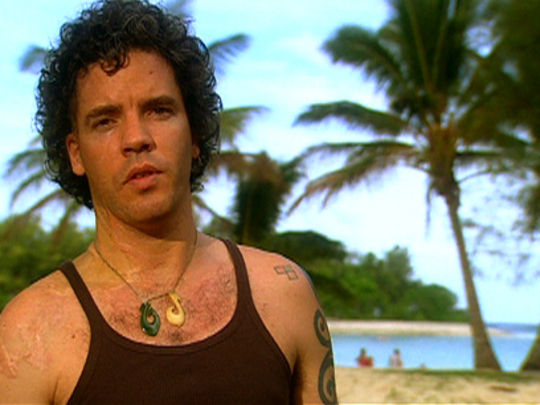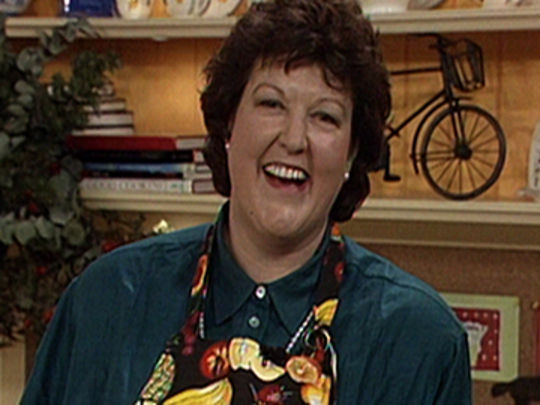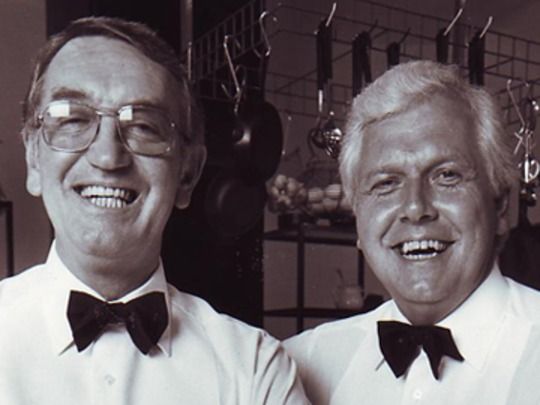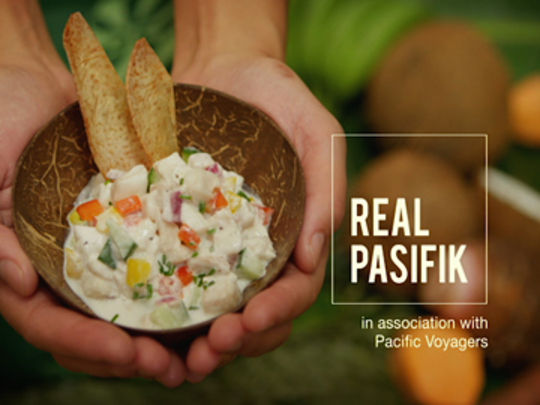











The Food Show Collection
The Food Show Collection
This collection has two backgrounds:
Kiwi Cuisine On-Screen

So Simple A Child Can Do It

Kiwi Cuisine On-Screen

By Peter Gordon 27 Mar 2025
Welcome to the wonderful and tasty world of kai, both here in Aotearoa New Zealand and overseas — as seen through the eyes of cooks and chefs, food writers, food producers, and some terrific personalities. Sitting down at a table and sharing a meal is integral to us as a society, whether it be a restaurant experience for two, a meal at home with your friends and whānau, or a hākari at the marae. But of course, it’s not always possible.
Looking at the programmes included in this Food Shows Collection, you can witness the changing face of eating, cooking and foraging over the years, as our dining experience starts to include food trucks and farmers markets, campfire and hāngī cooking — and an influx of ingredients not from here, but now seemingly part of our diet. In the collection you will learn some great recipes, but you’ll also travel around the country (and the Pacific), go foraging, harvest kaimoana, drop into rural communities to see what makes them tick, and connect with other cultures.
The vibrant food scene in Aotearoa is evolving even as I type; it's becoming both more local (as we delve into our indigenous edible plants and understand their uses) and more international, as we engage with our new migrants. And this cross-section showcases some of that. What I love about the collection — and many others on NZ On Screen — is that the far and recent past can be easily accessed. There’s so much to explore.
I began my food journey while growing up in coastal Whanganui in the 60s. I decided, aged four or five, that I wanted to be a chef. This was a little strange as my family never ate at restaurants. I made my first cookbook scrapbook at the age of four, and a second when I was eight. In between, I had a terrible accident when I fell off a stool and pulled the deep fryer of that night’s dinner over myself, which resulted in three hospital visits and a skin graft. But it didn’t put me off wanting to cook.
Initially, I became interested in being a chef from reading recipes in the women's magazines that my mum and stepmum had, especially if there were photos to accompany them. It was all fuel for a young mind. Then one day when I was five I saw Graham Kerr, our first celebrity chef, on the TV. Suddenly it all came to life.
It was a black and white show on New Zealand's only TV channel at the time, with a live studio audience, and it was electrifying — seeing Graham beat egg whites with a balloon whisk (I’d never seen one), make creamy scrambled eggs in a frypan (not a big pot as we did at home), and all sorts of other culinary wizardry. Suddenly the world of cooking became incredibly exciting, and a very real possibility. In the collection, you can see Graham hosting a Q&A in 1966 to a rather elegantly dressed and bejewelled audience, of mostly female fans. Gone are the days of the studio audience wearing pearls, hats, suits, and ties.
My next food memories include hilarious TV cooks Hudson and Halls. Peter Hudson and David Halls first hit our screens in 1976, just as I started fourth form at high school. This outrageously camp couple were adored by most of the country. Their shows were an insight not just into fancy food, but also ‘alternative lifestyles’ — they never came out as gay, but I think we all knew they weren’t just flatmates. The episode here seems entirely unscripted, which makes for some great television.
Other great TV cooks who made a mark on Kiwis include the wonderful Alison Holst in the mid 80s, and Jo Seager, who debuted in 1998. We trusted these two fabulous women, and they taught simple common sense dishes. Along with the TV shows, they produced cookbooks. The world of the celebrity chef was underway.
Thankfully we've moved on since those early days of male cooks, when TV focused especially on the cuisine of Britain and France. Now we happily engage with kai from here and the Pacific, as well as local chefs travelling abroad, and savour insights from migrant communities who have moved to Aotearoa New Zealand.
In 2001 I co-created and hosted Peter Gordon’s Pacific Harvest. I think of the show as "from pawpaw to pāua". I start in the Cook Islands, grating coconut for a raw fish salad; then head to Aotearoa and the Waikato River, to get some tuna (eel); I fly in an old biplane looking for deer in the Wairarapa; cook with fresh water kōura/crayfish, baby salmon and local olive oil in Marlborough; dredge for Bluff oysters in Foveaux Strait; and finish at the Bluff, cooking baby pāua at Pāua House. My premise was that in order to get to the heart of a place, it’s good to start at the stomach. I like to think it’s a great insight into modern-day Aotearoa.
In 2003 author and TV cook Peta Mathias hosted a Christmas special featuring four wonderful singers and musicians — Hinewehi Mohi, Brooke Fraser, King Kapisi, and bass-baritone Conal Coad. Peta gets her own song too. There’s less food in this than many food shows, but you get to see some seasonal Christmas kai.
Pio Terei cooks a hāngī in his backyard in one-off documentary My Kinda Kai (2004). We travel with Pio as he sources food from around Aotearoa, then brings it all together in a delicious pit in his backyard. There’s a lot of kaimoana/seafood in here; the segment on the tradition of muttonbirding and crafting pōhā/seaweed bags to preserve the harvested birds is terrific.
Beloved Wellington restaurateurs Steve Logan and chef Al Brown brought Hunger for the Wild to our screens in 2006. In those days, the food at their restaurant Logan Brown could be described as 'fancy Kiwi'. But the show had them fishing, foraging and hunting around the country, ending each episode with a delicious casual feast accompanied by local wines.
In 2003 Māori Television first went to air, and Kai Time On the Road premiered. The two episodes here are from 2012, directed and presented by chef Pete Peeti, who did all but the last two seasons. Pete is a fluent te reo speaker and it’s good to see a show with the courage to have no translation, as Pete and his guests' kōrero is a big part of the series. As the title suggests, this is a road trip looking at food around the country.
Series Real Pasifik was a long overdue look into the food and culture of our Pacific neighbours, by chef and author Robert Oliver. The show follows Robert as he travels to the Cook Islands, Samoa, Vanuatu, Fiji and to Auckland — the Polynesian capital of the world. In each episode he connects local chefs with local food producers and traditional methods of cooking, to elevate their menus. Also look out for the second season from 2014.
Matua Joe McLeod hit our screens in 2013 in bilingual cooking series Joe’s World on a Plate, for Māori Television. The two episodes here showcase our globetrotting chef as he combines recipes and flavours from his travels with local ingredients — including some of the 70 native greens used in traditional Māori cuisine. He teaches us three tasty courses in each episode.
In 2016 sisters Karena and Kasey Bird (winners of MasterChef New Zealand in 2014) headlined their own series, Kitchen Diplomacy. In this first episode, they head to South Korea, where they present a gorgeous Kiwi-Korean fusion meal of exquisite small plates. They split up in order to get more done, as the clock is ticking — Kasey heads to the markets, and Karena has a lesson in making kimchi from an expert — before cooking their meal in the smallest kitchen imaginable.
And in 2023, Sik Fan Lah! hit our screens, which translates as "time to eat". The show has a revolving door of hosts. Student and "meme queen" Abigail Leonita Masengi describes her episode as a degustation of modern Kiwi-Chinese life. The roasting of a whole pig is well worth watching, along with how to make mooncakes and some dumpling insights. Brilliant, contemporary and very tasty.
So take your time and have a look around the collection, to get an understanding of how kai fits into the fabric of our society — from our kitchens at home, to a BBQ on a beach, foraging in our forests and eating from food trucks. It’s definitely worth a look at the older shows, both to see how far we’ve come (we've often looked towards Europe for inspiration), and to compare to more recent shows, which highlight fabulous indigenous kai.
- Peter Gordon introduced fusion cuisine to London, as one of the trio behind award-winning restaurant The Sugar Club. The chef and author has appeared on television in both the UK (Jamie Oliver's Oliver's Twist, Nigel Slater's Real Food) and NZ (The Great Kiwi Bakeoff, Fusion Feasts, Peter Gordon's Pacific Harvest).
So Simple A Child Can Do It

By Simon Holst 27 Mar 2025
When I was growing up, life in our house revolved around food. I know that the kitchen is often regarded as the heart of the home, which indicates the central role that food plays in all of our lives. But when I think back to my own childhood, it really did play a huge part. My mother Alison was a great teacher, and would get us involved in the kitchen from an early age, sometimes as a way to keep us entertained. It also meant she could keep an eye on us while she was developing and testing recipes that would later appear in her books, or even on TV. We enjoyed food, we discussed it at the table, compared various versions of a recipe to find the best — we just lived it!
I quite vividly remember being taught how to bone, roll and roast lamb flaps, at the age of about 10. I'm sure it was partly so Alison could later truthfully say "it’s so simple, a child can do it". Then there was all the fun I had being shown how to make and cook on (the now incredibly politically incorrectly named) 'hobo stoves' — which she would later show on What Now?
Alison's passion for food started at home too. She was raised in a family where food was important — her mother regarded feeding family, friends (and all comers really) as a way of showing she cared — as an expression of love. But for Alison things snowballed, and food took on an even more significant role. She trained as a home science teacher, then taught at the Home Science School at the University of Otago, and at evening classes.
The NZ Broadcasting Corporation came looking for a new face to front a show — a show featuring everyday food as something of a foil for Graham Kerr, whose food was proving a little 'chefy'. Alison’s name came up, and as they say, the rest is history!
Alison became a trusted figure to many of her viewers. While it’s easy to look back now, and think how plain the food she prepared on her early shows was (garlic and soy sauce were highly exotic!), the trust she was given enabled her to be a quiet innovator. If Alison uses it, it must be okay.
There's something about watching cooking shows that you don’t get from other media. There’s nothing like seeing someone using a new ingredient or demonstrating a new technique to give you the confidence to try it yourself!
Browse through this selection, and you’ll meet a variety of other great Kiwi foodies — all bringing their own passion and expressing it in their own unique ways, and adding their own contributions to our own, now rich, food culture.
- Simon Holst has written or co-written more than 50 cookbooks. He now works in food safety.